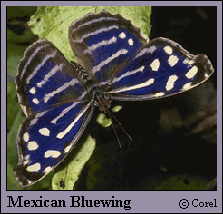 |
 

 |



Mexican Bluewing (Myscelia ethusa [Boisduval])
Wing span: 2 1/2 - 3 inches (6.4 - 7.6 cm).
Identification: Forewing apex is truncated. Upperside is black with iridescent blue bands; outer half of forewing has white spots.
Life history: Young caterpillars make a resting perch by attaching dung pellets and silk to a leaf vein. The adults rest on tree trunks with wings closed, exposing their undersides which look like bark.
Flight: Many flights throughout the year in South Texas.
Caterpillar hosts: In the tropics, Dalechampia in the spurge family (Euphorbiaceae).
Adult food: Rotting fruit.
Habitat: Stream valleys with dry scrub or scattered tropical forest.
Range: Colombia north through Central America to Mexico. Periodically strays and lives in the lower Rio Grande Valley, Texas.
Conservation: Conserve remaining Tamaulipan brushland habitats in the lower Rio Grande Valley, Texas.
The Nature Conservancy Global Rank: G4 - Apparently secure globally, though it might be quite rare in parts of its range, especially at the periphery.
Management needs: Expand the lower Rio Grande Valley refuge complex. Protect existing habitats on refuges.
References:
Opler, P. A. and V. Malikul. 1992. A field guide to eastern butterflies. Peterson
field guide #4. Houghton-Mifflin Co., Boston. 396 pages, 48 color plates.
Scott, J. A. 1986. The butterflies of North America. Stanford University Press,
Stanford, Calif. 583 pages, 64 color plates.
Author: Jane M. Struttmann

